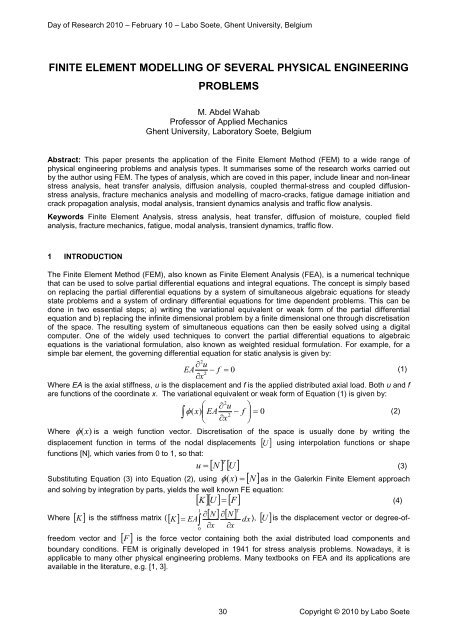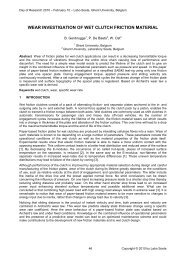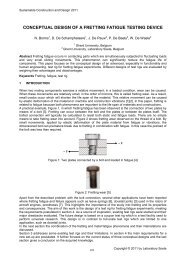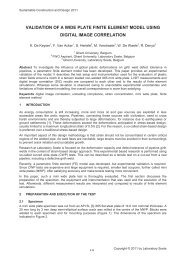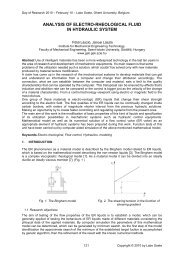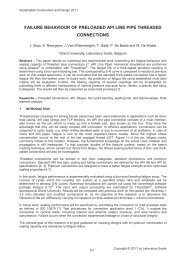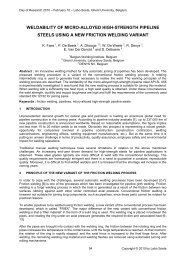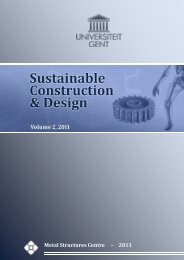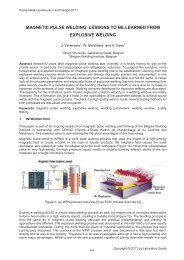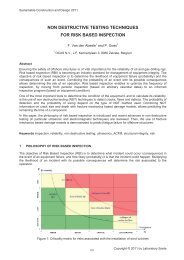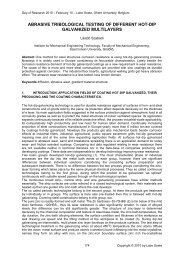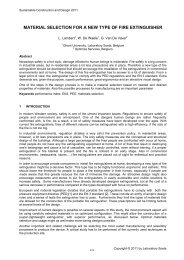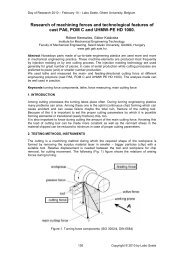F - 5th International Conference on Sustainable Construction and ...
F - 5th International Conference on Sustainable Construction and ...
F - 5th International Conference on Sustainable Construction and ...
You also want an ePaper? Increase the reach of your titles
YUMPU automatically turns print PDFs into web optimized ePapers that Google loves.
Day of Research 2010 – February 10 – Labo Soete, Ghent University, Belgium<br />
FINITE ELEMENT MODELLING OF SEVERAL PHYSICAL ENGINEERING<br />
PROBLEMS<br />
M. Abdel Wahab<br />
Professor of Applied Mechanics<br />
Ghent University, Laboratory Soete, Belgium<br />
Abstract: This paper presents the applicati<strong>on</strong> of the Finite Element Method (FEM) to a wide range of<br />
physical engineering problems <strong>and</strong> analysis types. It summarises some of the research works carried out<br />
by the author using FEM. The types of analysis, which are coved in this paper, include linear <strong>and</strong> n<strong>on</strong>-linear<br />
stress analysis, heat transfer analysis, diffusi<strong>on</strong> analysis, coupled thermal-stress <strong>and</strong> coupled diffusi<strong>on</strong>stress<br />
analysis, fracture mechanics analysis <strong>and</strong> modelling of macro-cracks, fatigue damage initiati<strong>on</strong> <strong>and</strong><br />
crack propagati<strong>on</strong> analysis, modal analysis, transient dynamics analysis <strong>and</strong> traffic flow analysis.<br />
Keywords Finite Element Analysis, stress analysis, heat transfer, diffusi<strong>on</strong> of moisture, coupled field<br />
analysis, fracture mechanics, fatigue, modal analysis, transient dynamics, traffic flow.<br />
1 INTRODUCTION<br />
The Finite Element Method (FEM), also known as Finite Element Analysis (FEA), is a numerical technique<br />
that can be used to solve partial differential equati<strong>on</strong>s <strong>and</strong> integral equati<strong>on</strong>s. The c<strong>on</strong>cept is simply based<br />
<strong>on</strong> replacing the partial differential equati<strong>on</strong>s by a system of simultaneous algebraic equati<strong>on</strong>s for steady<br />
state problems <strong>and</strong> a system of ordinary differential equati<strong>on</strong>s for time dependent problems. This can be<br />
d<strong>on</strong>e in two essential steps; a) writing the variati<strong>on</strong>al equivalent or weak form of the partial differential<br />
equati<strong>on</strong> <strong>and</strong> b) replacing the infinite dimensi<strong>on</strong>al problem by a finite dimensi<strong>on</strong>al <strong>on</strong>e through discretisati<strong>on</strong><br />
of the space. The resulting system of simultaneous equati<strong>on</strong>s can then be easily solved using a digital<br />
computer. One of the widely used techniques to c<strong>on</strong>vert the partial differential equati<strong>on</strong>s to algebraic<br />
equati<strong>on</strong>s is the variati<strong>on</strong>al formulati<strong>on</strong>, also known as weighted residual formulati<strong>on</strong>. For example, for a<br />
simple bar element, the governing differential equati<strong>on</strong> for static analysis is given by:<br />
2<br />
u<br />
EA f 0<br />
(1)<br />
2<br />
x<br />
Where EA is the axial stiffness, u is the displacement <strong>and</strong> f is the applied distributed axial load. Both u <strong>and</strong> f<br />
are functi<strong>on</strong>s of the coordinate x. The variati<strong>on</strong>al equivalent or weak form of Equati<strong>on</strong> (1) is given by:<br />
2<br />
u <br />
( x)<br />
EA f 0<br />
2<br />
<br />
(2)<br />
x<br />
<br />
Where (x)<br />
is a weigh functi<strong>on</strong> vector. Discretisati<strong>on</strong> of the space is usually d<strong>on</strong>e by writing the<br />
displacement functi<strong>on</strong> in terms of the nodal displacements U using interpolati<strong>on</strong> functi<strong>on</strong>s or shape<br />
functi<strong>on</strong>s [N], which varies from 0 to 1, so that:<br />
u <br />
T<br />
N U<br />
(3)<br />
<br />
Substituting Equati<strong>on</strong> (3) into Equati<strong>on</strong> (2), using (<br />
x)<br />
N<br />
as in the Galerkin Finite Element approach<br />
<strong>and</strong> solving by integrati<strong>on</strong> by parts, yields the well known FE equati<strong>on</strong>:<br />
Where K is the stiffness matrix (K<br />
<br />
EA<br />
U F<br />
<br />
1<br />
T<br />
N N<br />
<br />
K (4)<br />
0<br />
x<br />
x<br />
dx<br />
F is the force vector c<strong>on</strong>taining both the axial distributed load comp<strong>on</strong>ents <strong>and</strong><br />
boundary c<strong>on</strong>diti<strong>on</strong>s. FEM is originally developed in 1941 for stress analysis problems. Nowadays, it is<br />
applicable to many other physical engineering problems. Many textbooks <strong>on</strong> FEA <strong>and</strong> its applicati<strong>on</strong>s are<br />
available in the literature, e.g. [1, 3].<br />
), U is the displacement vector or degree-offreedom<br />
vector <strong>and</strong> <br />
30 Copyright © 2010 by Labo Soete
Day of Research 2010 – February 10 – Labo Soete, Ghent University, Belgium<br />
2 STRESS ANALYSIS<br />
In stress analysis, the degrees of freedom are translati<strong>on</strong>s as in case of bar elements, plane elements <strong>and</strong><br />
3-D solid elements, <strong>and</strong>/or rotati<strong>on</strong>s as in case of beam elements, plate elements <strong>and</strong> shell elements. For<br />
linear elastic analysis, Equati<strong>on</strong>s (4) is solved for the degree-of-freedom vector for a given stiffness matrix<br />
<strong>and</strong> force vector. After obtained, the degrees of freedom, the strain comp<strong>on</strong>ents are calculated from the<br />
compatibility equati<strong>on</strong>, i.e. the relati<strong>on</strong>ship between strains <strong>and</strong> the displacements or rotati<strong>on</strong>s, as follows:<br />
<br />
B U<br />
(5)<br />
Where Bis the strain-displacement or compatibility matrix. The stresses are then calculated from the<br />
strains using the c<strong>on</strong>stitutive equati<strong>on</strong> or stress/strain relati<strong>on</strong>ship, i.e.<br />
<br />
D <br />
(6)<br />
Where D<br />
is the c<strong>on</strong>stitutive matrix. An example for linear elastic stress analysis for a hydraulic Manifold<br />
due to in-service system pressure is shown in Figure 1, where v<strong>on</strong> Mises stress c<strong>on</strong>tour is plotted [4]. Due<br />
to symmetry, <strong>on</strong>ly half of the manifold was modelled using 3-D solid elements. The manifold was made of<br />
steel <strong>and</strong> the maximum applied pressure was 68 MPa.<br />
In case of geometric n<strong>on</strong>-linearity (large deformati<strong>on</strong>) or material n<strong>on</strong>-linearity (elastic-plastic), the stiffness<br />
matrix becomes functi<strong>on</strong> of the unknown degrees of freedom so that Equati<strong>on</strong> (4) becomes:<br />
K(<br />
U)<br />
U<br />
F<br />
The soluti<strong>on</strong> cannot be obtained in <strong>on</strong>e step <strong>and</strong> an iterative soluti<strong>on</strong> is required. Furthermore, due to the<br />
n<strong>on</strong>-linear force-displacement or stress-strain behaviour, an incremental soluti<strong>on</strong> is necessary. Thus, the<br />
incremental soluti<strong>on</strong> for n<strong>on</strong>-linear stress analysis problems becomes:<br />
K(<br />
U<br />
) U<br />
F<br />
(7)<br />
<br />
U<br />
is the incremental displacement vector, F<br />
is the incremental force vector <strong>and</strong> <br />
Where<br />
is the<br />
incremental residual force vector, which should be equal to zero for a c<strong>on</strong>verged soluti<strong>on</strong>. The iterative<br />
soluti<strong>on</strong> is usually solved using Newt<strong>on</strong>-Raphs<strong>on</strong> method. An example for a large deformati<strong>on</strong> analysis is<br />
shown in Figure 2, where the deformati<strong>on</strong> of a road sweeping brush is plotted [5]. The brush was made of<br />
steel tines <strong>and</strong> modelled using beam elements. The deformed shape in Figure 2 is for a flat flicking brush,<br />
which is in c<strong>on</strong>tact with the ground <strong>and</strong> has a penetrati<strong>on</strong> of 50 mm.<br />
Figure 1. Linear elastic analysis of a<br />
Hydraulic Manifold – v<strong>on</strong> Mises stress (MPa)<br />
Figure 2. Large deformati<strong>on</strong> analysis of a<br />
road sweeping brush – deformed shape<br />
An example of material n<strong>on</strong>-linearity finite element modelling is a thick walled tube subjected to autofrettage<br />
process [6], which is usually used in manufacturing barrels of h<strong>and</strong>guns, rifles, artillery, <strong>and</strong> cann<strong>on</strong>s<br />
mounted <strong>on</strong> military aircrafts. Autofrettage is carried out by means of an oversized m<strong>and</strong>rel or swage that is<br />
forced through the bore creating a regi<strong>on</strong> of plastic deformati<strong>on</strong>. The m<strong>and</strong>rel is then withdrawn so that the<br />
elastic material surrounding the plastic z<strong>on</strong>e attempts to return to its undeformed state. The material that is<br />
permanently deformed partially prevents this resp<strong>on</strong>se. Hence a compressive residual hoop stress field is<br />
created at the inner surface of the tube. Figure 3 shows a plot of the residual hoop stress in a 2-D<br />
axsymmetric model of the thick walled tube. An elastic perfectly plastic material model was used <strong>and</strong> the<br />
autofrettage process was simulated through the applicati<strong>on</strong> of an overstrain (overstrain is defined as<br />
R , where R m is the m<strong>and</strong>rel radius <strong>and</strong> R i is the inner radius of the tube). The overstrain has<br />
m<br />
R i<br />
been applied to the tube by prescribing the corresp<strong>on</strong>ding interference at the inner wall side as initial<br />
31 Copyright © 2010 by Labo Soete
Day of Research 2010 – February 10 – Labo Soete, Ghent University, Belgium<br />
boundary c<strong>on</strong>diti<strong>on</strong>. The prescribed interference was applied gradually until it reaches its maximum value;<br />
then it was removed gradually in order to simulate the unloading process. The FE results are also<br />
compared to the analytical soluti<strong>on</strong> in Figure 3, for three different overstrain values, namely Φ = 25, 60 <strong>and</strong><br />
R R<br />
R<br />
m i<br />
100 % ( 100%<br />
).<br />
i<br />
R i<br />
R s<br />
R o<br />
Figure 3. Residual hoop stress in an autofrettaged tube (MPa)<br />
3 HEAT TRANSFER ANALYSIS<br />
In heat transfer analysis, the degree of freedom is usually temperature. In general, there are two types of<br />
analysis, namely steady state analysis <strong>and</strong> transient analysis. In steady state analysis, the temperature<br />
distributi<strong>on</strong> <strong>and</strong> related quantities are determined under steady state c<strong>on</strong>diti<strong>on</strong>, i.e. variati<strong>on</strong> over time is<br />
ignored. Whereas in transient analysis, the temperature distributi<strong>on</strong> <strong>and</strong> related quantities are determined<br />
at different time intervals. The governing differential equati<strong>on</strong> for isotropic heat transfer in 3-D space, also<br />
known as the heat equati<strong>on</strong>, is given by:<br />
2 2 2<br />
T<br />
K T T T <br />
<br />
<br />
<br />
(8)<br />
2 2 2<br />
t<br />
cp<br />
x<br />
y<br />
z<br />
<br />
Where t is time, K is thermal c<strong>on</strong>ductivity (J/m.s. o C or W/m. o C), is mass density (kg/m 3 ), c<br />
p<br />
is specific<br />
heat capacity (J/kg. o C) <strong>and</strong> T is temperature, which is functi<strong>on</strong> of space <strong>and</strong> time. Applying the variati<strong>on</strong>al<br />
formulati<strong>on</strong> or weighted residual formulati<strong>on</strong> to Equati<strong>on</strong> (8), the FE c<strong>on</strong>ducti<strong>on</strong> heat transfer equati<strong>on</strong> is<br />
obtained as:<br />
T<br />
<br />
C<br />
K<br />
T q<br />
(9)<br />
<br />
t<br />
<br />
<br />
Where K is the c<strong>on</strong>ductivity matrix, C is the specific heat matrix, T is the temperature vector,<br />
T<br />
is<br />
<br />
t<br />
<br />
<br />
the rate of change of temperature vector over time <strong>and</strong> q is the heat flux vector. Equati<strong>on</strong> (9) is solved<br />
using numerical integrati<strong>on</strong>, usually Euler integrati<strong>on</strong> scheme, in which the derivative of temperature with<br />
respect to time is approximated as<br />
T T(<br />
t t)<br />
T(<br />
t<br />
<br />
) , where T( t t)<br />
is the temperature at time step<br />
t<br />
t<br />
t t <strong>and</strong> T (t)<br />
is the temperature at time step t. For steady state analysis, the problem is independent<br />
of time, thus the term c<strong>on</strong>cerned with time in Equati<strong>on</strong> (9) is eliminated, <strong>and</strong> the FE equati<strong>on</strong> is reduced to:<br />
K T q<br />
(10)<br />
An example of steady state c<strong>on</strong>ductivity heat transfer FEA is a Railko Marine Bearing [7]. The bearing<br />
c<strong>on</strong>sists of two layers, namely a backing <strong>and</strong> a liner. The backing has a thermal c<strong>on</strong>ductivity of 0.35<br />
W/m. o C <strong>and</strong> a thickness of 28 mm, while the liner has a thermal c<strong>on</strong>ductivity of 0.22 W/m. o C <strong>and</strong> a<br />
thickness of 21 mm. The average inner diameter is 740 mm <strong>and</strong> the outer diameter is 838 mm. 2-D plane<br />
heat transfer elements were used to model the two layers with mesh refinement near sharp corners <strong>and</strong> at<br />
interface. The inside temperature was 100 o C, whereas the outside temperature was 30 o C. Figure 4 shows<br />
the steady state temperature distributi<strong>on</strong> in the bearing.<br />
32 Copyright © 2010 by Labo Soete
Day of Research 2010 – February 10 – Labo Soete, Ghent University, Belgium<br />
Backing<br />
Liner<br />
Figure 4. Steady state heat transfer analysis - Temperature ( o C ) distributi<strong>on</strong> in Railko bearing<br />
4 DIFFUSION ANALYSIS<br />
In diffusi<strong>on</strong> FE analysis, the degree of freedom is moisture c<strong>on</strong>centrati<strong>on</strong>. The general form of the<br />
governing differential equati<strong>on</strong> for isotropic diffusi<strong>on</strong> in 3-D space can be expressed as:<br />
2 2 2<br />
c<br />
c c c <br />
D<br />
<br />
<br />
(11)<br />
2 2 2<br />
t<br />
x<br />
y<br />
z<br />
<br />
Where D is the diffusi<strong>on</strong> coefficient (m 2 /s) <strong>and</strong> c is the moisture c<strong>on</strong>centrati<strong>on</strong>, which is a functi<strong>on</strong> of time<br />
<strong>and</strong> space. The moisture c<strong>on</strong>centrati<strong>on</strong> c (also denoted as C ) is a dimensi<strong>on</strong>less quantity <strong>and</strong> varies<br />
between 0 <strong>and</strong> 1 with a value of 0 indicating dry c<strong>on</strong>diti<strong>on</strong>, <strong>and</strong> a value of 1 indicating fully saturated<br />
c<strong>on</strong>diti<strong>on</strong>. We can easily notice the similarity between Equati<strong>on</strong> (11) for diffusi<strong>on</strong> analysis <strong>and</strong> Equati<strong>on</strong> (8)<br />
for heat transfer. If we substitute byc<br />
p 1, K=D <strong>and</strong> T=c in Equati<strong>on</strong> (8), it becomes identical to Equati<strong>on</strong><br />
(11). Therefore, the heat transfer FE equati<strong>on</strong>s for steady state analysis (Equati<strong>on</strong> (10)) <strong>and</strong> for transient<br />
analysis (Equati<strong>on</strong> (9)) are applicable to diffusi<strong>on</strong> analysis. Furthermore, in commercial FE packages, a<br />
diffusi<strong>on</strong> analysis can be performed using heat transfer element with different interpretati<strong>on</strong> of the physical<br />
meaning of the degree of freedom <strong>and</strong> its related quantities. An example of a transient diffusi<strong>on</strong> analysis is<br />
a lap strap joint [8] shown in Figure 5. The lap strap joint c<strong>on</strong>sists of two substrates made of carb<strong>on</strong> fibre<br />
reinforced polymer (CFRP) composite materials b<strong>on</strong>ded together using adhesives. The adhesive layer has<br />
a rectangular fillet at the edge of the joint. The diffusi<strong>on</strong> coefficient used in the analysis presented in Figure<br />
13<br />
5 for adhesive was 9.310<br />
m 2 13<br />
/s <strong>and</strong> for the composite material was 3.6 10 m 2 /s. The transient<br />
diffusi<strong>on</strong> analysis was performed in the commercial software ANSYS using heat transfer elements. As initial<br />
<strong>and</strong> boundary c<strong>on</strong>diti<strong>on</strong>s, all edges including composites, adhesive <strong>and</strong> fillet are assumed to be saturated<br />
(i.e. all edges are exposed). The distributi<strong>on</strong> of moisture c<strong>on</strong>centrati<strong>on</strong> al<strong>on</strong>g the centre of the adhesive<br />
layer is plotted in Figure 5 after three different exposure times, 10, 20 <strong>and</strong> 30 days.<br />
C <br />
Figure 5. Transient diffusi<strong>on</strong> FE analysis for a lap strap adhesive joint<br />
33 Copyright © 2010 by Labo Soete
Day of Research 2010 – February 10 – Labo Soete, Ghent University, Belgium<br />
5 COUPLED-FIELD ANALYSIS<br />
A coupled-field analysis, also known as multi-physics analysis, is a combinati<strong>on</strong> of two or more dependent<br />
analyses from different physics field. The output of <strong>on</strong>e analysis would be the input for the next analysis.<br />
For example, after performing heat transfer analysis, the temperature distributi<strong>on</strong> would generate thermal<br />
strains, which can be applied to a subsequent stress analysis. We present herein two examples of coupled<br />
field analysis, namely thermal-stress analysis <strong>and</strong> diffusi<strong>on</strong>-stress analysis. The steps that are involved in<br />
performing the coupled field analyses are summarised in Figure 6(a). The same finite element mesh should<br />
be used for both heat transfer <strong>and</strong> stress analyses. However, the element type should be switched from<br />
heat transfer element to structural element. If the mechanical properties are thermal or moisture dependent,<br />
they have to be defined for each element according to its temperature or moisture c<strong>on</strong>centrati<strong>on</strong>. The<br />
thermal strains ( <br />
t<br />
T<br />
, where is the coefficient of thermal expansi<strong>on</strong> <strong>and</strong> T T T<br />
with<br />
ref<br />
T the<br />
calculated temperature <strong>and</strong> T a reference or strain free temperature) or swelling strains ( c<br />
,<br />
ref<br />
where is the coefficient of swelling <strong>and</strong> c is the moisture c<strong>on</strong>centrati<strong>on</strong>) are calculated for each element.<br />
s<br />
The mechanical loads, if any, are applied <strong>and</strong> the stress analysis is solved. The first example is the<br />
thermal-stress analysis of the Railko bearing [7] presented in secti<strong>on</strong> 3. The mechanical properties of the<br />
backing were Elastic modulus E = 37 GPa <strong>and</strong> Poiss<strong>on</strong>’s ratio=0.3 <strong>and</strong> for the liner: Elastic modulii E x =19<br />
GPa, E y =39 GPa, E z =20 GPa <strong>and</strong> Poiss<strong>on</strong>’s ratio=0.3, where x is the radial directi<strong>on</strong>, y is the hoop directi<strong>on</strong><br />
<strong>and</strong> z is the axial directi<strong>on</strong>. A c<strong>on</strong>tour of the hoop stress due to <strong>on</strong>ly thermal strains is shown in Figure 6(b).<br />
The sec<strong>on</strong>d example is the diffusi<strong>on</strong>-stress analysis of the lap strap joint [9] presented in secti<strong>on</strong> 4. The<br />
mechanical properties for the adhesive were dependent <strong>on</strong> the moisture c<strong>on</strong>centrati<strong>on</strong>. Therefore, the<br />
stress-strain resp<strong>on</strong>se for each adhesive element was defined <strong>on</strong> the basis of the moisture c<strong>on</strong>centrati<strong>on</strong> in<br />
the element. For CFRP composite substrates, the moisture didn’t affect the mechanical properties. A<br />
mechanical load of 5 kN was applied to the joint. A plot of the peel stress in the adhesive layer al<strong>on</strong>g the<br />
adhesive/substrate interface is shown in Figure 6(c). The joints were aged in hot/wet envir<strong>on</strong>ment,<br />
90 o C/97%RH up to saturati<strong>on</strong> (denoted as 90 wet in Figure 6(c)) <strong>and</strong> tested in dry at 90 o C (denoted as<br />
/dry) <strong>and</strong> wet 97%RH at 90 o C (denoted as /wet) c<strong>on</strong>diti<strong>on</strong>s.<br />
d<br />
s<br />
Heat transfer<br />
or diffusi<strong>on</strong><br />
analysis<br />
Switch element<br />
type from heat<br />
transfer to<br />
structural element<br />
Define thermal or<br />
moisture dependent<br />
mechanical<br />
properties<br />
Apply thermal<br />
strains or swelling<br />
strains <strong>and</strong><br />
mechanical loads<br />
Solve<br />
stress<br />
analysis<br />
(a)<br />
(b)<br />
(c)<br />
Figure 6. Coupled-field analysis: (a) Procedures, (b) Thermal-stress analysis of Railko bearing<br />
<strong>and</strong> (c) Diffusi<strong>on</strong>- stress analysis of lap strap joint.<br />
6 FRACTURE MECHANICS ANALYSIS<br />
Fracture mechanics analysis using FEA involves two main steps, namely; a) modelling of macro-crack <strong>and</strong><br />
b) extracting fracture mechanics parameters from stress analysis results. When modelling the crack in FEA,<br />
the crack faces should coincident but not c<strong>on</strong>nected together. The elements around the crack tip should be<br />
quadratic to capture the high stress <strong>and</strong> stain gradient near the crack tip, as shown in Figure 7(a). In Linear<br />
Elastic Fracture Mechanics (LEFM), the displacement variati<strong>on</strong> near the crack tip is proporti<strong>on</strong>al to the<br />
square root of the distance from the crack tip ( u r ) <strong>and</strong> the stress <strong>and</strong> strain singularity is of the square<br />
34 Copyright © 2010 by Labo Soete
Day of Research 2010 – February 10 – Labo Soete, Ghent University, Belgium<br />
1 1<br />
root type ( & ). In such a case, the quarter point singularity elements [10], in which the midside<br />
nodes at the crack tip are shifted to the quarter positi<strong>on</strong> in order to produce square-root stress<br />
r r<br />
singularity, as show in Figure 7(b). In Elastic-Plastic Fracture Mechanics (EPFM), the stress singularity is<br />
not of the square root type <strong>and</strong> has an order of 1 , where m is the power law c<strong>on</strong>stant in the<br />
m 1<br />
1<br />
Ramberg–Osgood equati<strong>on</strong> [11] ( ) <strong>and</strong> the strain singularity has an order of m<br />
1<br />
m 1<br />
m1<br />
r<br />
1<br />
( ). Also, in composite materials when cracks terminate at an interface, the order of the singularity<br />
m<br />
m1<br />
r<br />
<br />
is no more of the square root type <strong>and</strong> has a general order ( u r & r 1 ), which can be a real<br />
number 0 1, or a complex number, depending <strong>on</strong> the geometry of the problem <strong>and</strong> material<br />
properties. To approximate the general power type singularity in FEA, special crack tip elements as the <strong>on</strong>e<br />
shown in Figure 7(c) have been developed [12, 13]. After obtaining the FE results, fracture mechanics<br />
parameters such as stress intensity factor, strain energy release rate <strong>and</strong> J-integral can be calculated.<br />
There are many computati<strong>on</strong>al techniques to extract fracture mechanics parameters from FE results. We<br />
present herein two simple techniques to calculate the stress intensity factor <strong>and</strong> the strain energy release<br />
rate using the nodal displacements behind the crack tip <strong>and</strong> the nodal forces ahead of it. C<strong>on</strong>sider the<br />
arrangement of nodes in a quarter point element as shown in Figure 7(b), a two-point formula for<br />
calculating the stress intensity factor for a symmetric cark is given by [14]:<br />
E 2<br />
K (4 )<br />
1 2<br />
4 <br />
I<br />
uy i<br />
u<br />
y<br />
(12)<br />
i<br />
L<br />
Where E is the Elastic modulus <strong>and</strong> u <strong>and</strong> u are the crack opening displacements of nodes i-1 <strong>and</strong> i-2,<br />
y i1<br />
y i2<br />
respectively. For the same arrangement of nodes shown in Figure 7(b), the strain energy release rates for<br />
mode I <strong>and</strong> mode II, derived from a virtual crack closure approach, are given by [15]:<br />
2u<br />
yi1<br />
GI<br />
( Fy<br />
1.5<br />
4 F )<br />
i1<br />
y<br />
(13)<br />
i<br />
L<br />
2ux<br />
i1<br />
G ( F 1.5 4 F<br />
(14)<br />
II<br />
xi<br />
1<br />
)<br />
L<br />
Where F x <strong>and</strong> F y are the crack closure nodal forces in the x <strong>and</strong> y directi<strong>on</strong>s, respectively, <strong>and</strong> u x <strong>and</strong> u y are<br />
the crack sliding <strong>and</strong> opening displacements, respectively. Deformati<strong>on</strong> near an interface crack in a lap<br />
strap joint [16] is shown in Figure 7(d).<br />
xi<br />
(a)<br />
(b)<br />
(c)<br />
(d)<br />
Figure 7. Fracture mechanics analysis: (a) FE mesh at a crack tip, (b) Quarter point, (c) General<br />
power singularity element <strong>and</strong> (d) Deformati<strong>on</strong> near a crack tip.<br />
7 FATIGUE ANALYSIS<br />
Fatigue analysis combines stress analysis with either c<strong>on</strong>tinuum damage mechanics for fatigue crack<br />
initiati<strong>on</strong> analysis or fracture mechanics for fatigue crack propagati<strong>on</strong> analysis. In c<strong>on</strong>tinuum damage<br />
mechanics, the fatigue damage accumulati<strong>on</strong> is represented by a damage variable D, which is equal to<br />
zero for a virgin material <strong>and</strong> 1 for a fully damaged material. The damage variable can be calculated from<br />
FE stress analysis results, providing that some damage material parameters are given. For low cycle<br />
fatigue, the damage variable (D) is expressed as [17]:<br />
1<br />
/ 2<br />
1 <br />
m<br />
<br />
D 1<br />
A m 1 <br />
m1<br />
eq R<br />
<br />
V<br />
N <br />
<br />
(15)<br />
35 Copyright © 2010 by Labo Soete
Day of Research 2010 – February 10 – Labo Soete, Ghent University, Belgium<br />
Where N is the number of cycles,<br />
eq<br />
is the range of v<strong>on</strong>-Mises stress, R V is the triaxiality functi<strong>on</strong>, m is<br />
the power c<strong>on</strong>stant in Ramberg-Osgood equati<strong>on</strong>, <strong>and</strong> A <strong>and</strong> are damage parameters, which can be<br />
determined experimentally. For given N, m, A <strong>and</strong> , the range of v<strong>on</strong>-Mises stress<br />
eq <strong>and</strong> triaxiality<br />
functi<strong>on</strong> R V can be determined from stress analysis results, <strong>and</strong> therefore D can be calculated using<br />
Equati<strong>on</strong> (15). An example of the evoluti<strong>on</strong> of D in an adhesive layer with fillet used for a scarf joint [18] is<br />
shown in Figure 8.<br />
N = 1<br />
D max = 0.002<br />
N = 15<br />
D max = 0.038<br />
Figure 8. Fatigue damage evoluti<strong>on</strong> in adhesive layer<br />
N = 28<br />
D max = 0.204<br />
In fatigue crack propagati<strong>on</strong> analysis, a crack growth equati<strong>on</strong> (e.g. Paris law) is numerically integrated<br />
within a FE stress analysis. A modified Paris law that includes the threshold <strong>and</strong> accelerating crack growth<br />
regi<strong>on</strong>s is given by [19]:<br />
n<br />
<br />
1<br />
G <br />
<br />
<br />
<br />
<br />
th<br />
da 1<br />
<br />
n Gmax<br />
<br />
DG<br />
<br />
(16)<br />
max <br />
n2<br />
dN<br />
<br />
G <br />
<br />
<br />
<br />
<br />
max<br />
1<br />
<br />
<br />
Gc<br />
<br />
Where da/dN is the crack growth rate, G max is the maximum strain energy release rate at a specific stress<br />
ratio, G th is the fatigue threshold, G c is the fracture toughness, <strong>and</strong> n, n 1 <strong>and</strong> n 2 are c<strong>on</strong>stants. A procedure<br />
that is used to numerically integrate the crack growth law in FE analysis is shown in Figure 9. This<br />
procedure has been implemented in the FE package ANSYS. The applicati<strong>on</strong> of the crack propagati<strong>on</strong><br />
procedure to a single lap joint is shown in Figure 10 [19]. Only half of the joint was modelled with rotati<strong>on</strong>al<br />
symmetric boundary c<strong>on</strong>diti<strong>on</strong>s in the mid-plane. The number of cycles to failure were calculated twice for<br />
each load value; a) using the total strain energy release rate (G max or G T ) <strong>and</strong> b) using the mode I strain<br />
energy release rate (G I ).<br />
Initial c<strong>on</strong>diti<strong>on</strong><br />
a=a o <strong>and</strong> applied<br />
load F=F i<br />
FE stress<br />
analysis,<br />
Crack length=a i<br />
Determine<br />
G max or G I<br />
Small crack<br />
increment<br />
a<br />
Calculate (da/dN)<br />
from equati<strong>on</strong> (16)<br />
Draw F-N f<br />
(load - number<br />
of cycles to<br />
failure) diagram<br />
No<br />
Yes<br />
Another load be<br />
c<strong>on</strong>sidered?<br />
(F i =F i-1 +F)<br />
No<br />
Yes<br />
Has ‘a’ reached<br />
the maximum<br />
allowable crack<br />
length (a f )?<br />
Figure 9. Fatigue crack propagati<strong>on</strong> procedure<br />
Calculate new<br />
‘N’ <strong>and</strong> ‘a’ as:<br />
N i+1 =N i +N<br />
a i+1 =a i +a<br />
Calculate N i<br />
as:<br />
N i =a i /(da/dN)<br />
Figure 10. Fatigue crack propagati<strong>on</strong> in a single lap joint<br />
36 Copyright © 2010 by Labo Soete
Day of Research 2010 – February 10 – Labo Soete, Ghent University, Belgium<br />
8 MODAL ANALYSIS<br />
FE Modal analysis is performed to determine the natural frequencies <strong>and</strong> the mode shapes of a structure in<br />
free vibrati<strong>on</strong>. The FE equati<strong>on</strong> that should be solved in modal analysis is derived from the generalised<br />
equati<strong>on</strong> of moti<strong>on</strong>, which is given by:<br />
M<br />
U<br />
C<br />
U<br />
K<br />
U<br />
F<br />
(17)<br />
Where K is the stiffness matrix, U is the displacement vector, C is the damping matrix, <br />
derivative of the displacement vector with respect to time (velocity vector), M is the mass matrix, U <br />
U is the first<br />
F is the<br />
force vector. For un-damped free vibrati<strong>on</strong>, both damping matrix <strong>and</strong> force vector are equal to zero <strong>and</strong><br />
Equati<strong>on</strong> (17) becomes:<br />
M U K U <br />
(18)<br />
the sec<strong>on</strong>d derivative of the displacement vector with respect to time (accelerati<strong>on</strong> vector) <strong>and</strong> <br />
0<br />
The displacement time resp<strong>on</strong>se soluti<strong>on</strong> of this differential Equati<strong>on</strong> isU<br />
U<br />
sin( t <br />
)<br />
, where the<br />
m n<br />
vector U m<br />
c<strong>on</strong>tains the maximum amplitude for each degree of freedom, <br />
n<br />
is the angular frequency <strong>and</strong><br />
is the phase angle. Differentiating the displacement twice with respect to time <strong>and</strong> substituting in<br />
Equati<strong>on</strong> (18), yields:<br />
2<br />
[ K]<br />
[ M ] U <br />
(19)<br />
0<br />
n<br />
Equati<strong>on</strong> (19) is an eigenvalue problem, which has ‘n’ number of eigenvalues (angular frequencies) <strong>and</strong><br />
eigenvectors (mode shapes). The eigenvalue problem is solved using iterative numerical soluti<strong>on</strong> such as<br />
inverse iterati<strong>on</strong> method, <strong>and</strong> tridiag<strong>on</strong>alisati<strong>on</strong> <strong>and</strong> QR algorithm. An example of FE modal analysis is the<br />
free vibrati<strong>on</strong> of a pre-stressed c<strong>on</strong>crete bridge, B14 [20]. The B14 bridge, built in 1971, is located between<br />
the two villages Peutie <strong>and</strong> Melsbroek <strong>and</strong> crosses the highway E19 between Brussels <strong>and</strong> Antwerp in<br />
Belgium. It has an overall length of 89 m, a width of 13 m <strong>and</strong> two traffic lanes. The bridge has three spans<br />
<strong>and</strong> is supported by two piers <strong>and</strong> two abutments. A 3-D finite element model was c<strong>on</strong>structed using solid<br />
elements <strong>and</strong> modal analysis was performed. Due to symmetry, <strong>on</strong>ly <strong>on</strong>e-quarter of the bridge was<br />
modeled with appropriate symmetric or anti-symmetric boundary c<strong>on</strong>diti<strong>on</strong>s in order to determine all<br />
symmetric <strong>and</strong> anti-symmetric modes of vibrati<strong>on</strong>. The FE mesh c<strong>on</strong>sists of 3321 brick elements <strong>and</strong> 4938<br />
nodes. Figure 11 shows the first three mode shapes of the bridges B14.<br />
m<br />
is<br />
Mode 1 – 2.35 Hz Mode 2 – 3.28 Hz Mode 3 – 4.40 Hz<br />
Figurer 11. FE Modal analysis of bridge B14<br />
9 TRANSIENT DYNAMICS ANALYSIS<br />
Transient dynamics analysis, also known as time-history analysis, is c<strong>on</strong>cerned with the determinati<strong>on</strong> of<br />
the time resp<strong>on</strong>se of a structure, i.e. displacements, strains, stresses as functi<strong>on</strong>s of time under the acti<strong>on</strong><br />
of time dependent loads. The FE equati<strong>on</strong> that should be solved in transient dynamics analysis is Equati<strong>on</strong><br />
(17), the generalised equati<strong>on</strong> of moti<strong>on</strong>. Because of the time dependent, Equati<strong>on</strong> (17) is solved in time<br />
steps using numerical integrati<strong>on</strong> such as Euler integrati<strong>on</strong> scheme. In the explicit direct numerical<br />
integrati<strong>on</strong> scheme, the velocity <strong>and</strong> accelerati<strong>on</strong> vectors at time step t are approximated as:<br />
1<br />
U<br />
( t)<br />
<br />
U<br />
( t t)<br />
U(<br />
t t)<br />
<br />
(20)<br />
2t<br />
1<br />
U<br />
( t)<br />
<br />
U<br />
( t t)<br />
2U<br />
( t)<br />
U(<br />
t t)<br />
<br />
2<br />
(21)<br />
t<br />
37 Copyright © 2010 by Labo Soete
Day of Research 2010 – February 10 – Labo Soete, Ghent University, Belgium<br />
With appropriate initial c<strong>on</strong>diti<strong>on</strong>s at t=0, soluti<strong>on</strong> of U at different time steps can be found, using<br />
Equati<strong>on</strong>s (17), (20) <strong>and</strong> (21). As the time step becomes smaller, the numerical soluti<strong>on</strong> c<strong>on</strong>verges to the<br />
exact soluti<strong>on</strong>. An example of a FE transient dynamics analysis is shown in Figure 12, where a footbridge,<br />
Wilcott bridge, is excited using a walking pedestrian [21]. The Wilcott footbridge is a newly c<strong>on</strong>structed FRP<br />
composite footbridge crossing the new A5 Nesscliffe Bypass near Shrewsbury, UK. Wilcott footbridge is a<br />
suspensi<strong>on</strong> bridge, has a single span of 50.24 m <strong>and</strong> provides a footway of 2.3 m wide. The finite element<br />
package ANSYS was used to simulate the transient dynamics resp<strong>on</strong>se of the footbridge. 3-D beam<br />
elements (Figure 12(a)) were used to model all the structural members including; cross beams, deck, posts,<br />
cables <strong>and</strong> hangers. Mass elements were used to model h<strong>and</strong>rails, ballast in the cells, <strong>and</strong> deck finishing. A<br />
time history analysis is performed to calculate the dynamic resp<strong>on</strong>se of the footbridge under the acti<strong>on</strong> of a<br />
walking pedestrian at a frequency close to the sec<strong>on</strong>d vertical natural frequency of the bridge (1.6 Hz).<br />
Humans walking pacing rate normally lies in the range 1.6-2.4Hz. The vertical dynamic load induced <strong>on</strong> the<br />
footbridge by a pedestrian taken from BS5400 is a pulsating moving load of: F(t)=180sin(ω.t) N. The<br />
displacement time resp<strong>on</strong>se in the mid-span of the bridge is shown in Figure 12(b).<br />
u (cm)<br />
(a)<br />
Figurer 12. Wilcott bridge: (a) FE model <strong>and</strong> (b) Mid-span resp<strong>on</strong>se due to a walking pedestrian<br />
(b)<br />
10 TRAFFIC FLOW ANALYSIS<br />
In traffic flow analysis, the degree of freedom is the traffic density. The governing partial differential<br />
equati<strong>on</strong> of traffic flow is known by LWR (Lighthill, Witham <strong>and</strong> Richards) model. For <strong>on</strong>e dimensi<strong>on</strong>al<br />
c<strong>on</strong>stant speed traffic flow, LWR equati<strong>on</strong> is given by [22]:<br />
k<br />
u<br />
t<br />
k<br />
0<br />
x<br />
o<br />
(22)<br />
Where k is the traffic density (vehicle/m), which is a functi<strong>on</strong> of time <strong>and</strong> space, <strong>and</strong> uo<br />
is the traffic speed<br />
(m/s). Applying variati<strong>on</strong>al formulati<strong>on</strong> or Galerkin method to Equati<strong>on</strong> (22), the FE equati<strong>on</strong> in matrix form<br />
is obtained as:<br />
k<br />
<br />
<br />
t<br />
<br />
<br />
B k<br />
0<br />
A (23)<br />
Again, the soluti<strong>on</strong> of Equati<strong>on</strong> (23) is obtained in different time steps using numerical integrati<strong>on</strong>. An<br />
example of traffic flow analysis is a simulati<strong>on</strong> of a 5 km road [22], where the boundary c<strong>on</strong>diti<strong>on</strong>s at the<br />
beginning of the road (x=0) are as shown in Figure 13(a). The c<strong>on</strong>vergence of traffic flow density at a<br />
distance of 2 km is plotted in Figure 13(b) by c<strong>on</strong>sidering different element sizes (Δx).<br />
(a)<br />
(b)<br />
Figurer 13. FE traffic flow analysis: (a) Boundary c<strong>on</strong>diti<strong>on</strong>s at the beginning of the road x=0 <strong>and</strong> (b)<br />
C<strong>on</strong>vergence of density at x= 2 km as functi<strong>on</strong> of Δx<br />
38 Copyright © 2010 by Labo Soete
Day of Research 2010 – February 10 – Labo Soete, Ghent University, Belgium<br />
11 CONCLUSIONS<br />
The Finite Element Method is a generic technique that can be used in several disciplines <strong>and</strong> can be<br />
applied to many physical engineering problems. Although many disciplines <strong>and</strong> applicati<strong>on</strong>s have been<br />
covered in this paper, there are still other disciplines, which have not been c<strong>on</strong>sidered, such as electromagnetic,<br />
acoustics <strong>and</strong> fluid mechanics, where FEM can provide very useful numerical soluti<strong>on</strong>s.<br />
Nowadays, FEA is well established numerical technique <strong>and</strong> many commercial software’s are available for<br />
educati<strong>on</strong>al purposes <strong>and</strong> industrial uses. However, research <strong>and</strong> development into FEM is still going <strong>on</strong> in<br />
order to improve accuracy, facilitate the user interacti<strong>on</strong> with the software <strong>and</strong> further implementati<strong>on</strong> of<br />
specific applicati<strong>on</strong>s.<br />
12 REFERENCES<br />
[1] R.D. Cook, D.S. Malkus <strong>and</strong> M.E. Plesha, C<strong>on</strong>cept <strong>and</strong> applicati<strong>on</strong>s of finite element analysis, John<br />
Wiley & S<strong>on</strong>s, USA, Third editi<strong>on</strong>, 1989.<br />
[2] T.R. Ch<strong>and</strong>rupatla <strong>and</strong> A.D. Belegundu, Introducti<strong>on</strong> to finite elements in engineering, Pears<strong>on</strong><br />
Educati<strong>on</strong>, USA, Third editi<strong>on</strong>, 2002.<br />
[3] S. Moaveni, Finite element analysis: theory <strong>and</strong> applicati<strong>on</strong> with ANSYS, Pears<strong>on</strong> Educati<strong>on</strong>, USA,<br />
Sec<strong>on</strong>d editi<strong>on</strong>, 2003.<br />
[4] M. M. Abdel Wahab, Stress analysis of a Manifold for Heypac pumps, Heypac Ltd, Internal Report,<br />
University of Surrey, December, 2000.<br />
[5] M.M. Abdel Wahab, G.A.Parker <strong>and</strong> C.Wang, Modelling Rotary Sweeping Brushes <strong>and</strong> Analyzing Brush<br />
Characteristic using Finite Element Method, Finite Element in Analysis <strong>and</strong> Design, 43, 521-532, 2007.<br />
[6] M. M. Abdel Wahab, S. A. K<strong>and</strong>il, M. S. Abdel-kader <strong>and</strong> M. Moustafa, Stress intensity factor calculati<strong>on</strong><br />
for autofrettaged tube test-specimens using finite element method, 9 th <str<strong>on</strong>g>Internati<strong>on</strong>al</str<strong>on</strong>g> <str<strong>on</strong>g>C<strong>on</strong>ference</str<strong>on</strong>g> <strong>on</strong><br />
Aerospace Sciences & Aviati<strong>on</strong> Technology, ASAT- 9,Cairo, Egypt, May 8-10, 2001.<br />
[7] A. W. E. Henham <strong>and</strong> M. M. Abdel Wahab, Railko Marine Integrated Bearings, Railko Ltd, Internal<br />
Report, University of Surrey, UK, June, 2001.<br />
[8] M. M. Abdel Wahab, I. A. Ashcroft, A. D. Crocombe <strong>and</strong> S. J. Shaw, Diffusi<strong>on</strong> of moisture in adhesively<br />
b<strong>on</strong>ded joints, Journal of Adhesi<strong>on</strong>, 77, 43-80, 2001.<br />
[9] I. A. Ashcroft, M.M. Abdel Wahab <strong>and</strong> A.D. Crocombe, Predicting degradati<strong>on</strong> in b<strong>on</strong>ded composite<br />
joints using a semi-coupled FEA finite element method, Mechanics of Advanced Materials <strong>and</strong> Structures,<br />
10, 227-248, 2003.<br />
[10] R.S. Barsoum, On the use of isoparametric finite elements in linear elastic fracture mechanics, Inter. J.<br />
Numer. Meth. Engng, 10, 25-37, 1976.<br />
[11] W. Ramberg <strong>and</strong> W.R. Osgood, Descripti<strong>on</strong> of stress-strain curves by three parameters, Technical<br />
Note No. 902, Nati<strong>on</strong>al Advisory Committee For Aer<strong>on</strong>autics, Washingt<strong>on</strong> DC, 1943.<br />
[12] M. M. Abdel Wahab <strong>and</strong> G. De Roeck, A 3-D six-noded finite element c<strong>on</strong>taining a singularity,<br />
<str<strong>on</strong>g>Internati<strong>on</strong>al</str<strong>on</strong>g> Journal of Fracture, 70, 347-356, 1995.<br />
[13] M. M. Abdel Wahab <strong>and</strong> G. De Roeck, A 2-D five noded finite element to model power singularity,<br />
<str<strong>on</strong>g>Internati<strong>on</strong>al</str<strong>on</strong>g> Journal of Fracture, 74, 89-97, 1995.<br />
[14] J. Martinez <strong>and</strong> J. Dominguez, Short Communicati<strong>on</strong> <strong>on</strong> the Use of Quarter-Point Boundary Elements<br />
for Stress Intensity Factor Computati<strong>on</strong>s, Int. J. Num. Meth. Engn., 20, 1941-1950, 1984.<br />
[15] M. M. Abdel Wahab, On the use of fracture mechanics in designing a single lap adhesive joint, Journal<br />
of Adhesi<strong>on</strong> Science <strong>and</strong> Technology (ISSN 0169-4243), Vol. 14, No. 6, pp. 851-866, 2000.<br />
[16] M. M. Abdel Wahab, I. A. Ashcroft, A. D. Crocombe, D. J. Hughes <strong>and</strong> S. J. Shaw, The effect of<br />
envir<strong>on</strong>ment <strong>on</strong> the fatigue of composite joints: Part 2 fatigue threshold predicti<strong>on</strong>, Composites part A,<br />
32(1), 59-69, 2001.<br />
[17] M. M. Abdel Wahab, I. A. Ashcroft, A. D. Crocombe <strong>and</strong> S. J. Shaw, Predicti<strong>on</strong> of fatigue threshold in<br />
adhesively b<strong>on</strong>ded joints using damage mechanics <strong>and</strong> fracture mechanics, Journal of Adhesi<strong>on</strong> Science<br />
<strong>and</strong> Technology, 15(7), 763-782, 2001.<br />
[18] M. M. Abdel Wahab, I. Hilmy, I.A. Ashcroft <strong>and</strong> A.D. Crocombe, Damage parameters of adhesive joints<br />
with general triaxiality: Part 2 scarf joint analysis, J. of Adhesi<strong>on</strong> Science <strong>and</strong> Technology, to appear, 2010.<br />
[19] M.M. Abdel Wahab, I.A. Ashcroft, A.D. Crocombe <strong>and</strong> P.A. Smith, Numerical predicti<strong>on</strong> of fatigue crack<br />
propagati<strong>on</strong> lifetime in adhesively b<strong>on</strong>ded structures, <str<strong>on</strong>g>Internati<strong>on</strong>al</str<strong>on</strong>g> Journal of Fatigue, 24(6), 705-709, 2002.<br />
[20] M. M. Abdel Wahab <strong>and</strong> G. De Roeck, Dynamic testing of prestressed c<strong>on</strong>crete bridges <strong>and</strong> numerical<br />
verificati<strong>on</strong>, American Society of Civil Engineers, Journal of Bridge Engineering, 3(4), 159-169, 1998.<br />
[21] R.A. Votsis, M. M. Abdel Wahab <strong>and</strong> M.K. Chryssanthopoulos, Simulati<strong>on</strong> of damage scenarios in an<br />
FRP composite suspensi<strong>on</strong> footbridge, Key Engineering Materials, 293-294, 599-606, 2005.<br />
[22] W. Ceulemans, M. M. Abdel Wahab, K. De Proft <strong>and</strong> G. Wets, Modelling traffic flow with c<strong>on</strong>stant<br />
speed using the Galerkin finite element method, World C<strong>on</strong>gress <strong>on</strong> Engineering, The Proceedings of The<br />
<str<strong>on</strong>g>Internati<strong>on</strong>al</str<strong>on</strong>g> <str<strong>on</strong>g>C<strong>on</strong>ference</str<strong>on</strong>g> of Applied <strong>and</strong> Engineering Mathematics, 993-999, L<strong>on</strong>d<strong>on</strong>,1-3 July, 2009.<br />
39 Copyright © 2010 by Labo Soete


